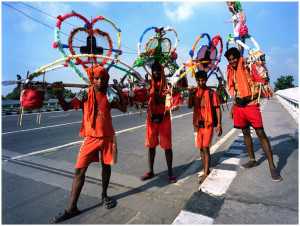During July and August in northern India, you may encounter Indians, often young, wearing orange and walking around a cart. These Indians are celebrating kanwar yatra.
Every year, those celebrating Shiva get together at the Ganga’s sources, at Haridwar, Guamukh, and Gogotri in Uttarkhand and at Sultangan in Bihar. They take part in a ceremony honoring Shiva, the Kanwar mela. They collect the Ganga water to bring it back to temples dedicated to Shiva, in their city of origin. These pilgrims walk some 100 kilometers by foot, to join these pilgrimage cities. The celebration takes place during the Shavran month (July-August).
Among Indians on the road of mela, the Shivaïtes are the most fervent admirers of Shiva. The people belonging to this sect live off offerings by believers. Its members are considered as saints, distinguished by the three lines on their forehead and their safran-colored cloths. Today, all participants of the Kanwar yatra harbor this color.
Before the 1990s, this event gathered only a couple hundred of believers. For 15 years, several thousand of believers are traveling from northern states to the pilgrimage places. You might notice participants are very young. Their mission consists in walking long distance. However, the modes of transport are increasing, just like the number of pilgrims.
The government seriously monitors this walk. The walkers mobilize many roads and can create some troubles. Moreover, the government is concerned because of the consumption of cannabis. The hemp is easily growing in those regions. In an article published in August, 6 in the Times of India, this tendency has grown increasingly strong for many young Indians. Cannabis helps them to walk long distances. Furthermore, floats broadcast pop and electro music along the way, something really enjoyed by the young pilgrims. By following them, you could even think being in a festival. Unfortunately, this event doesn’t make everyone as happy as it seems. Eldest participants and local people keep complaining about this modernism.


 Français
Français

